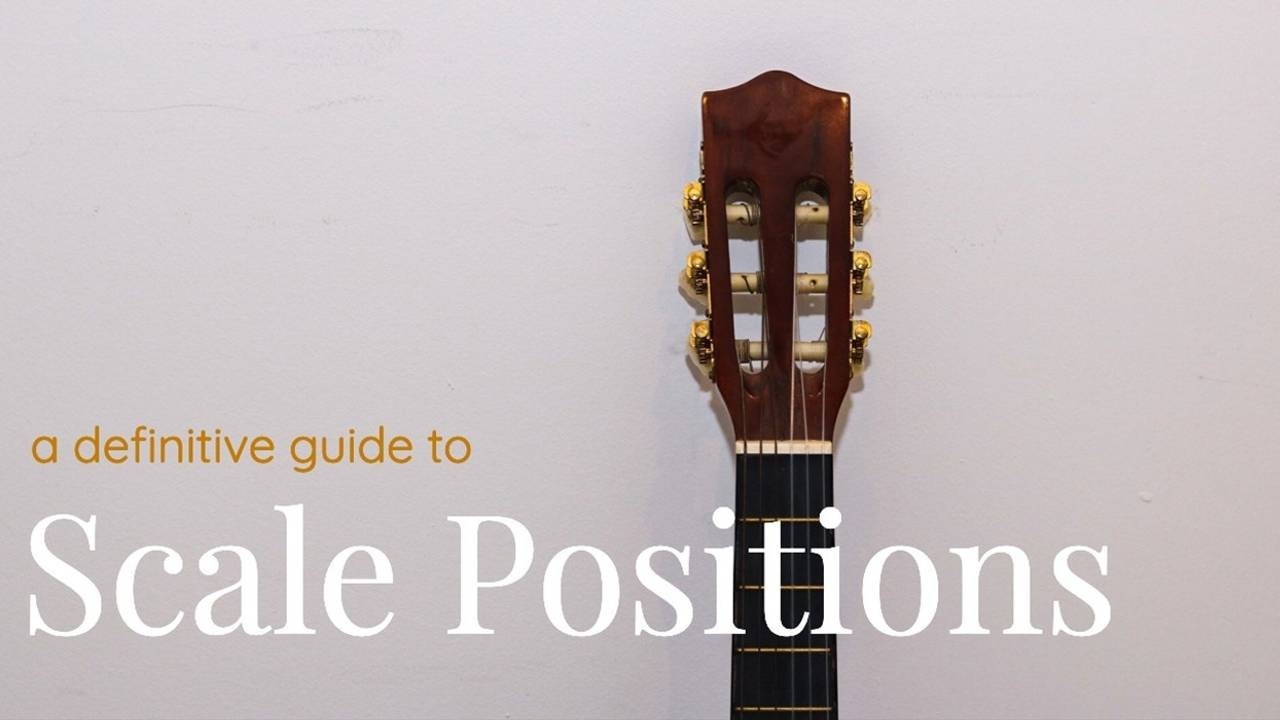
The Definitive Guide to Scale Positions for Jazz Guitar
Nov 09, 2020How Jazz Guitarists Memorize the Fretboard with Basic Positions and Patterns
Scale positions are the “meat and potatoes” of jazz guitar scales playing. Any melodic idea can be analysed and explained on the fingerboard as belonging to one or more positions.
In this article you will learn to properly place your hand on the fingerboard, understand the fingering principles and finally, learn jazz guitar scales in some of the most useful positions.
We will look at the fundamental aspects of learning the proper positions and fingerings for the most common jazz guitar scales: major scale and melodic minor scale. Click on their names for a theoretical explanation.
Table of Contents
Part One Learn the "Finger to Fret" Relationship
Part Two: Top Must-Know Positions for Jazz Guitar
Part Three: Scales Polishing and Connecting
Addendum: Scales Through the Cycle of Fourths
Scale Positions Part One: Learn the “Finger to Fret” Relationship
If this article was a one-liner, it would probably be just that subtitle. This is the core of all position playing on the guitar: each finger stays on one fret. But that is not all…
The other part of this principle that is probably less understood is that fingers can stretch, increasing the area of the same position. It means that each finger stays in one fret, except the index and the pinky that can stretch higher or lower by one fret.
This enables the 1st and 4th fingers to stretch to:
- add extra range to each position on the guitar;
- create a whole new world of fingering possibilities.
In short the hand now spans six frets instead of four and that'll have people checking to see how many fingers you have. (six fingers?)
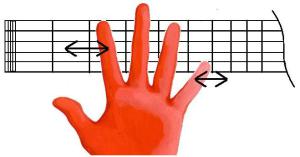
This is a picture of the finger to fret relationship. It should be the same as if you look at your fretting hand in a mirror while fingering your guitar. Notice how the index (1st finger) and the pinky (4th finger) each cover two frets. After you get comfortable with the concept, it will feel akin to having six fretting fingers!
If you’re completely new to position playing I recommend you check out and play through A Modern Method for Guitar by William Leavitt. It will give you a solid base in jazz guitar scale positions and fingerings.
The Whole Universe (it’s yours!)
Let’s see where the fingers fall in a typical position on the guitar. Try it yourself: put your fretting index over the third fret and all the other fingers should align with fret four, five and six.
So, musically, what do we have?
- The low register goes as low as an F# / Gb (second fret, lowest string) because we stretch the index down.
- The high register goes as far as a B (seventh fret, highest string) because we’re stretching the pinky up.
- All notes in between are present.

A typical position thus covers almost 2.5 octaves! That is in the ballpark of what most woodwinds and brass deal with. And don’t forget, that is just one position for us guitarists!
I often hear people use the expression, “Stuck in one position”. I wonder about that statement. How can you be “stuck” when such a huge amount of musical material is right at your fingertips? It’s most likely because people don’t know what to do with all these notes, more so than the lack of raw materials available!
And, what do I mean exactly?
I like to say that the whole universe is contained in a single position because you can find:
- The chromatic scale (spanning over 2 octaves).
- Two whole tone scales.
- Three diminished scales.
- 12 major, melodic minor, harmonic minor, harmonic major scales.
- All the 4, 5, 6 and 7-note chords/arpeggios derived from above.
- Every chromatic interval up to the 13th. Some can be doubled.
- 12 major, minor, augmented, diminished and sus. triads (all inversions in closed positions and some spread voicings.)
- _________________________________ (write your own)
And that is just the tip of the iceberg. You’ll find more if you look! In fact check out The Advancing Guitarist, by Mick Goodrick, where the author attempts to enumerate all the possibilities!
In short, just one position on the guitar is sufficient to deal with any musical situation. Everything is there! It’s the same as saying that “Just” the range of the alto saxophone is sufficient to deal with any musical situation. That’s obviously true.
Always Remember:
A range of approx 2.5 octaves (one position) contains the whole musical universe in itself. It’s all there! You just have to find what you need.
More Universes: Position Playing Principle
Even though we could spend our lives in just one or two positions, jazz guitarists tend to learn all, or most of the positions on the guitar. It’s practical to unlock the entire fretboard.
It’s almost like saying, "Instead of learning all the scales in one position, I will learn all the positions in one scale."
This means that jazz guitar scales are usually learned in “blocks” of between 5 and 7 different and useful positions for each scale. That is highly effective when it comes down to covering the entire fingerboard, especially if it is your first time doing so.
It’s also worth looking into diagonal playing for scales on jazz guitar. It’s not position-related, but it’s really cool!
Part Two: Top Must-Know Positions for Jazz Guitar
“Why just two scales?”
Most of jazz music is played within the major and melodic minor scales. They are building blocks and these jazz guitar scales should be mastered before attempting to learn more advanced (exotic, synthetic) scales. Make sure you somewhat understand what the above mentioned scales are and how they sound.
The “Starting String and Finger” System
Lets identify positions, not in an absolute manner by fret, but according to what finger and string the first note is played on. It is a relative system using the 6th (string) and 2nd (finger).
For example, “6-2” means that the first note of the position, also called root, is played with the second finger on the sixth string. That relative location can be applied to any fret on the guitar.
For example, if we say “G major scale in 6-2” it implies three things:
- Play a G note as a root…
- With your second finger…
- On the sixth string.
So “G major scale in 6-2” will have you place your 2nd finger on the 3rd fret of the 6th string (G note).
Seven Most Common Positions (String-Finger)
The following seven positions are to me, and many other professional guitarists, the most important ones. It’s essential that you learn them in and out if you want to master jazz guitar scales:
- 6-2
- 6-1
- 4-1
- 5-4
- 5-2
- 5-1
- 6-4
The fingerings with the same finger number are very similar (such as 6-2 and 5-2). It will help tremendously for memorization. More on that later. It probably doesn’t make any sense to you right now, so let’s play them! Each position is clearly explained (with tabs and diagram) below.
Demonstration: 7 Positions for the Major Scale
Let’s play the above mentioned positions in G major. I like that key because it lays well on the fretboard and the “string-finger” identifiers make sense.
We’ll start low on the fingerboard (near the nut) and climb all the way up. The positions will appear in the same order as they do on the bullet-list above.
A quick technical note: make sure your thumb is behind the neck when practicing the scales. Make the palm of your fretting hand as round as possible (as if you were holding a grapefruit.)
Also make sure that you practice the jazz guitar scale positions ascending and descending.
Ready?
GO!
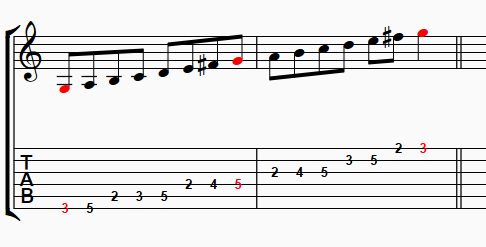
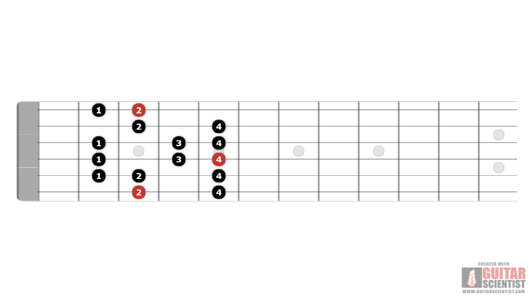

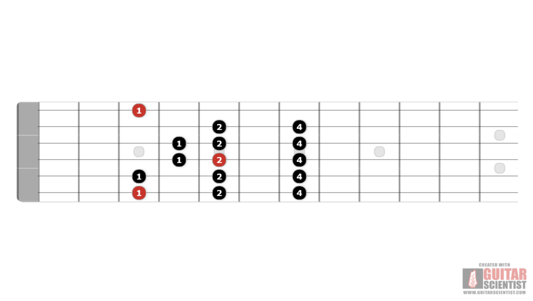
Notice that there are three 1st finger stretches in 6-1. Do not move the entire hand to play them. Simply reach for the notes with the index.

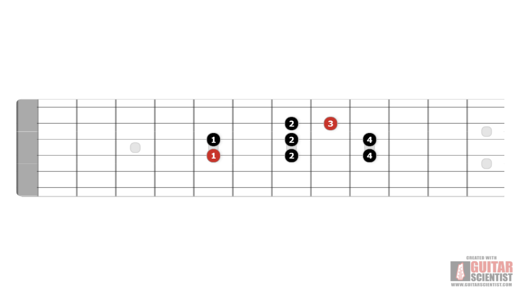

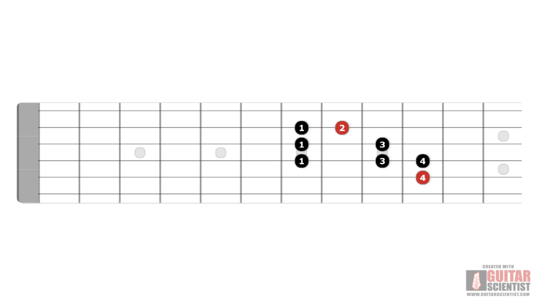
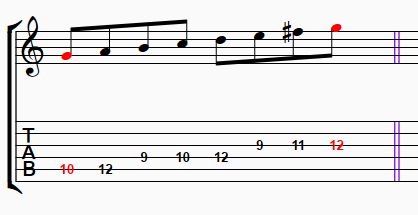

This is basically the same as 6-2 but on a different set of strings.


This is basically the same as 6-1 but on a different set of strings.


And finally, our pinky stretch! 6-4 is very much related to 5-4 but has this necessary stretch of the 4th finger.
How to Remember the 7 Positions of Major
Did you notice little things here and there? Similarities, recurring patterns or inherent logic? Of course you did!
The seven jazz guitar scale positions divide into three families or related fingerings:
- 6-2 and 5-2
- 6-4 and 5-4
- 6-1, 5-1 and 4-1
In short, the finger you start on decides on the fingering to adopt. We’re starting scales on either the 1st, 2nd or 4th finger, thus, 3 families, so only three master fingerings can be derived for seven positions.
You may have noticed that positions starting on the 6th string are mostly complete in themselves, covering almost the entire range of the fretting hand.
Go on to Part Three to find out how to fill-in the “missing notes” for jazz guitar scale positions 4-1, 5-4, 5-2 and 5-1.
Jazz Guitar Scales: Moving On
I’ll show you how to take full advantage of each of these jazz guitar scale positions. We still need to identify all the notes available in each position, not just from “root to root” …
Part Three: Scales Polishing and Connecting
A Quick Review First
In order to make the following topics clear, let’s see what we’ve learned so far. In dealing with positions and jazz guitar scales you should now understand that;
- A position is a physical location on the fretboard. The fretting hand can span up to 6 frets with index and pinky stretches
- The “whole universe”, musically speaking, is contained within any position. The range of any position is approx 2.5 octaves
- Seven positions are really useful on the fretboard
- The “finger – string” system determines the starting note/root of all positions we’re looking at on this website
- Three “families” of positions exist; they're divided by the starting finger with either the 1st, 2nd or 4th finger
- The seven positions apply to the major scale at first
- The seven positions then apply to the melodic minor scale simply by changing one note from the major scale fingerings
- The positions, tabs and diagrams in the previous jazz guitar scales are incomplete in themselves and we’ll address that right now!
OK, you’ve got the seven positions down and memorized? Good!
In melodic minor as well?
Don’t worry, it takes time to digest all that information. In the long run though, you want the seven positions of major and melodic minor (in 12 keys) to be part of the common stuff you play everyday.
But first...I'll let you in on a little secret.
This is my favorite part of the story! Without knowing it, and if you have learned the seven positions of the major scale properly, then you’ve also unlocked the seven positions of the melodic minor scale! How is that possible? If you know a minimum of scale theory you know that there’s only one note difference between major and melodic minor: The third!
So if C major is: C D E F G A B then C melodic minor is simply: C D Eb F G A B
Since we’ve been in G major above, we’ll simply change the B to a Bb. So, basically, all you have to do is go through the seven positions and change one note. To help you, I made a chart of melodic minor scale diagrams here:

Pay attention to the brand new finger stretches that occur!
Completing the Seven Positions
I would like to throw away the diagrams for now, using only tabs and music notation. I think I saw too many pictures of fretboards covered with dots in books. So here they are as promised: all the major positions “completed” with all the available notes in the reach of the hand in each of the seven positions. From now on, the concept of position incorporates all the available notes at all times.
You have to be conscious of every note that is within your reach in each position.
It is still in G major and this time the example will ascend / descend to cover all the notes. Please see each scale as the complete position’s own little etude.

6-1
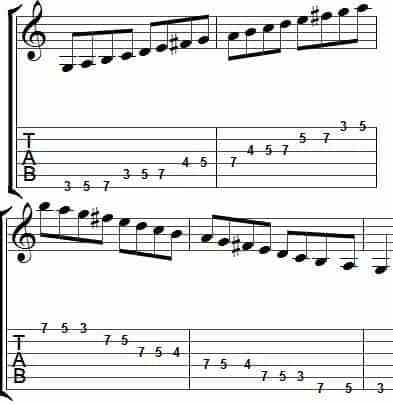
4-1
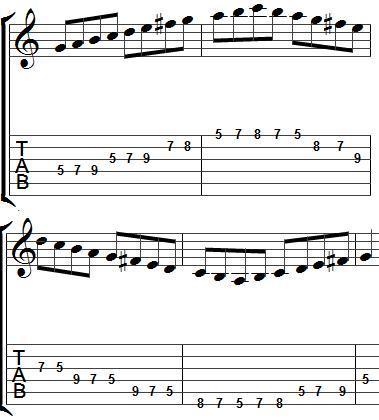
Remember to stretch the index to reach to the fifth fret. Frets 7, 8 and 9 should be played with the 2nd, 3rd and 4th fingers. Stick to that diligently. This also applies to 6-1 and 5-1.
Later on, if you want to experiment, you may want to use the exact same finger locations but reach out with the pinky instead. It will feel and play differently since the pinky is a weaker finger.
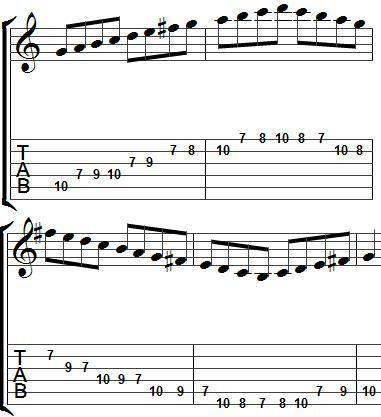
5-2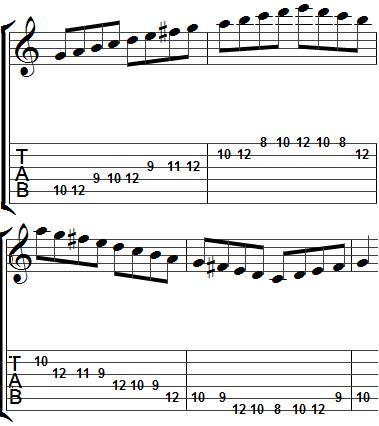
Pay attention. There is now a first finger stretch on the first and sixth string in this position.

Again, stretch with first finger…
6-4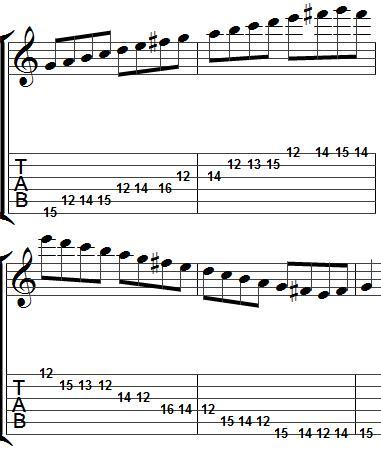
Only one finger stretch with the pinky.
Completing the Seven Positions (encore)
What do you think is happening with melodic minor now? Let me guess what’s on your mind.
You think that…
- …you could take the seven “complete” positions of G major above?
- …and change all the B’s to Bb’s?
- …and you’d have seven positions of G melodic minor?
And you also think that…
- …you should be careful with the new finger stretches that might happen along the way (especially in 5-4 and 6-4)?
Wow! You've got it, but sorry, because there are no diagrams, tabs or notation provided. You have to work at melodic minor all by yourself. It’s a valuable part of the process. You’ll thank me for that later. (-:
Mastering the Connections between Seven Positions
Et voilà!
If you came this far, you’re only one step away from mastering the jazz guitar scales in seven positions. Congratulations! Of course, you could (and should) spend a lifetime refining your chops, patterns, transcriptions, improvisations, etc. but the basics of the positions are now ingrained for you.
The last step involves connecting the seven positions together, one after another, and going up and down the neck. You play the same G major scale for example, in all the positions, consecutively and without stopping. That’ll fix ya!
By the way, Barry Galbraith wrote a great book on connecting scales for the guitar neck. It’s called “The Fingerboard Workbook: Concepts in Logical Fingering”. It's the one with the blue cover.
Take Home PDF: Jazz Guitar Scales Connected
I wrote an etude (in PDF) for you to play. Remember to use all the proper fingerings for the seven positions before experimenting. Also keep in mind that the position shifts occur between half-steps (one fret):
- In major between the 3rd and 4th or the 7th-8th degrees of the scale
- In melodic minor only between the 7th and 8th degrees
For example, in G major, you shift between B and C or F# and G. In G melodic minor, you can only shift between F# and G.
Here’s what it sounds and looks like when you play it.
Moving On
If you believe you have mastered position playing, the next logical step is to play jazz guitar scales diagonally. Here’s an article on the basics of diagonal scales playing.
Addendum: Scales Through the Cycle of Fourths
So far in this article, we've looked at the fundamental aspects of learning the proper positions, fingerings and position shifts for the most common jazz guitar scales: major scale and melodic minor scale.
Here’s a little jazz guitar scales trick to help memorize the fingerings and positions by using the cycle of fourths.
Cycling on Your Jazz Guitar Scales
Practice the same material we examined in part 2 and part 3 and play the exact same seven positions / fingerings through the cycle of fourths!
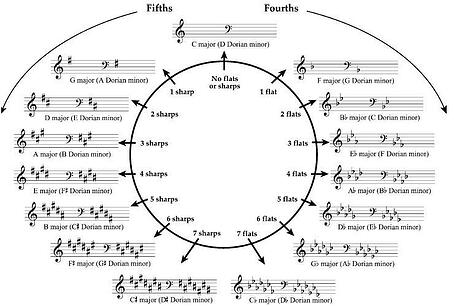
Provided that the key of the next scale you’re about to play is up a fourth, you will be able to use the left hand in one position for playing several different key signatures.
In part 2 and 3, we stayed in one key while moving the left hand through seven positions up and down the fretboard. In this addendum, you will learn to stay in one position going through SEVEN keys, varying only the fingerings.
Let’s Try it!
If you’ve done your homework, you should be at least familiar with the seven useful positions/fingerings for jazz guitar scales. If not, the string + finger system still applies. Here’s the order in which the seven fingerings move through the "Circle of Fourths”:
6-4
5-4
6-2
5-2
6-1
5-1
4-1
Demonstration
Play the first scale with your pinky on C on the 6th string, thus playing the C scale in 6-4.
The next scale is F in 5-4,
then Bb in 6-2,
then Eb in 5-2,
then Ab in 6-1,
then Db in 5-1,
then Gb in 4-1.
This is all of the above seven keys while staying in the same left hand position.
… and start over a 1/2 step down
Having covered the seven useful fingerings in the keys of C, F, Bb, Eb, Ab, Db, Gb, the next scale in the cycle (key of B) uses 6-4 again, starting all over a half-step lower that where we started in C.
Cover the same seven fingerings this time starting in: B major in 6-4,
then E in 5-4,
then A in 6-2,
then D in 5-2,
then G in 6-1,
then C in 5-1,
then F in 4-1.
… and start over a 1/2 step down once again.
Bb in 6-4 again, to Eb in 5-4, to Ab in 6-2 etc.
…until you run out of frets by reaching the nut on your guitar!
Starting from 6-4 and playing scales in the Circle of Fourths allows you to play seven distinct fingerings and keys before having to move the left hand in a lateral fashion a half-step down.
In fact, you could start in any key, major or melodic minor scale, and play through the cycle! (-;
**Notes from the editor** This post was updated 11/11/2020. (Syntax, layout, vectorized images and feature image updated.)











